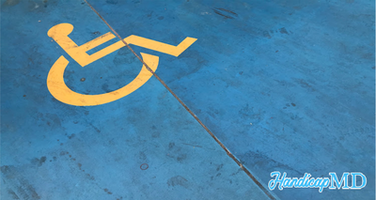
Tips for Displaying Your Handicap Placard Correctly in Connecticut
Disability parking tags, also known as disability placards, play an essential role in ensuring that individuals with disabilities have access to accessible parking spaces close to building entrances. These tags, issued by the Connecticut Department of Motor Vehicles (DMV), are designed to reduce the physical strain on individuals who have limited mobility, making everyday tasks like grocery shopping, attending medical appointments, or visiting public facilities more manageable.
While having a disability tag allows you to park in designated accessible spaces, it’s important to understand the correct way to display the tag in your vehicle. Misusing or improperly displaying your tag can result in fines, tickets, or even losing your parking privileges. By following the proper guidelines for displaying your disability tag in CT, you can ensure that you’re using the tag legally and effectively.
This article will cover everything you need to know about displaying your handicap placard correctly in Connecticut, including key tips to avoid common mistakes, rules about where and when to use the tag, and how to handle specific situations like damaged or expired tags. We’ll also provide a helpful FAQ section and offer a conclusion to wrap up the most important points.
Understanding the Purpose of a Handicap Placard
Why Proper Display Is Important
The purpose of a disability tag is to provide convenient access to accessible parking spaces for individuals with disabilities. These parking spots, which are marked with the international symbol of accessibility (the blue wheelchair symbol), are typically located near the entrances of public and private buildings, medical facilities, shopping centers, and other high-traffic areas.
Properly displaying your disability tag is crucial because it allows law enforcement and parking officials to identify your eligibility to park in these spaces. Failure to display the tag correctly can result in fines or the inability to access the accommodations you’re entitled to.
In CT, disability tags are intended to reduce the physical challenges faced by people with disabilities, but improper use can lead to penalties, so it’s essential to follow the rules and display your tag correctly.
The Types of Disability Tags in Connecticut
There are two main types of handicap permit issued in CT:
Permanent Disability Tag: This tag is for individuals with permanent disabilities. It is valid for five years and can be renewed before it expires.
Temporary Disability Tag: Issued to individuals with temporary disabilities, this tag is valid for up to six months and can be renewed if needed with updated medical certification.
Both types of tags allow the user to park in accessible handicap parking spaces, provided they are displayed correctly.
How to Apply for a Handicap Placard in Connecticut
Eligibility Criteria
To qualify for a disability tag in CT, you must have a medical condition that severely limits your ability to walk or requires the use of mobility aids such as a wheelchair, walker, or cane. Some common conditions that qualify include:
- Inability to walk 200 feet without stopping to rest.
- Severe lung or heart disease that restricts physical activity.
- Use of portable oxygen or other mobility aids.
- Neurological or musculoskeletal conditions that impair mobility.
You will need to provide medical certification from a licensed healthcare provider to verify your eligibility for a disability tag.
Application Process Overview
The application process for a Connecticut handicap placard is relatively simple:
Download the Application: The Special Parking Permit Application and Renewal form (Form B-225) can be found on the Connecticut DMV website.
Complete the Personal Information Section: Fill out your name, address, date of birth, and other personal details.
Obtain Medical Certification: Have a HandicapMD healthcare provider complete the certification section of the form, which confirms that you have a qualifying disability.
Submit the Application: Mail or deliver the completed application and any required documentation to the state's DMV. Once processed, your disability tag will be mailed to you.
How to Obtain a Permit Online with HandicapMD.com
HandicapMD.com offers a convenient telehealth service that simplifies the process of getting your disabled parking permit by allowing you to:
- Sign Up: Visit the HandicapMD.com website and fill out the necessary form to schedule a consultation.
- Consultation: A certified doctor will assess your medical records and determine whether you meet the eligibility criteria.
- Medical Certification: The doctor will complete the certification section of the Special Parking Permit Application and Renewal form (Form B-225).
- Submit Your Application: Once your form is completed, submit it to the state's DMV, either in person or by mail.
Why Getting the Permit Online is Beneficial
- Convenience: With HandicapMD.com, you don’t need to visit a doctor’s office. You can complete the entire process from home.
- Expertise: HandicapMD doctors specialize in understanding ADA guidelines and determining eligibility for disabled permits, ensuring a smoother process.
- Efficiency: The service allows for quick evaluations, helping you get your permit faster than traditional method.
Why Proper Tag Display Matters
Disability parking tags are provided to make life easier for individuals with mobility impairments, allowing access to parking spaces that are closer to building entrances and provide extra space for accessibility. But displaying your tag correctly goes beyond convenience—it helps to protect the integrity of accessible parking resources. Proper display prevents confusion, deters tag misuse, and allows law enforcement to quickly identify legitimate tag holders.
In CT, disability parking tags must be hung from the rearview mirror when the vehicle is parked in an accessible space. When driving, it’s essential to remove the tag from the rearview mirror to ensure an unobstructed view and prevent any driving hazards. Failure to display your tag correctly can lead to fines, penalties, or even revocation of your tag if misused.
Key Tips for Displaying Your Disability Tag Correctly
Displaying your handicap placard correctly ensures that you’re complying with the law and avoiding unnecessary fines. Here are some important tips for proper display in CT:
1. Always Hang the Tag When Parked
When using accessible parking spaces, the state's law requires that the disability tag be visible from the rearview mirror of your vehicle. Hanging it in this location ensures that enforcement officers can easily see it without needing to look into the vehicle, which speeds up the verification process and minimizes unnecessary interactions.
2. Remove the Tag When Driving
For safety reasons, it’s crucial to remove the disability tag from the rearview mirror while the vehicle is in motion. A tag left hanging while driving can obstruct your field of vision, creating a potential safety hazard. Removing the tag also helps to preserve it, reducing wear and tear over time.
3. Ensure the Tag is Facing Forward
When hanging the disability tag, make sure that the printed side is facing out, so it is easily visible to parking enforcement officers. This simple step helps officers confirm the tag’s validity and expiration date without having to open the vehicle, preventing misunderstandings or unnecessary fines.
4. Store the Tag Safely When Not in Use
Disability tags are usually made of durable materials, but they can still be damaged if not stored correctly. When not in use, place your tag in a safe location within your vehicle, such as the glove compartment or a dedicated storage pocket, to protect it from cracks, scratches, or warping. This ensures it remains in good condition and clearly visible.
5. Keep Your Tag Up to Date
Check the expiration date on your disability tag regularly. CT requires that tags be renewed periodically, and failure to renew them on time can result in fines or a temporary loss of parking privileges. The renewal process is straightforward and usually involves submitting an updated application to the state's Department of Motor Vehicles (DMV).
6. Avoid Leaving Your Tag Visible When Not Using Accessible Parking
When not parked in an accessible spot, it’s best to keep your tag stored away from sight. This prevents potential misuse by others who may see it as an opportunity to take advantage of accessible parking spaces. It also reduces the risk of theft, as disability tags are often valuable items that could be targeted for unauthorized use.
7. Report a Lost or Stolen Tag Immediately
If your disability tag is lost or stolen, report it to the state's DMV as soon as possible. Prompt reporting protects you from any potential misuse under your name and allows you to obtain a replacement quickly. The DMV can guide you through the process to replace your tag and ensure you can continue to access parking without interruptions.
8. Display Only a Valid Tag
Using an expired, invalid, or borrowed disability tag is illegal in CT and may result in fines, loss of accessible parking privileges, or even legal penalties. Be sure to always display your own valid tag. Lending it to others, even family members, is also prohibited and may lead to penalties.
9. Avoid Lamination or Altering Your Tag
Disability tags issued by the state's DMV come pre-made with durable materials. Avoid laminating, altering, or adding any extra coverings to the tag, as this could make it unreadable to enforcement officers and even cause penalties. If your tag is damaged, reach out to the DMV to request a replacement.
10. Familiarize Yourself with Accessible Parking Etiquette
Using a disability tag responsibly involves more than just correct display; it’s about respecting the needs of others. Avoid occupying accessible parking spaces if you don’t need the additional room or proximity, and be mindful not to obstruct the access aisles adjacent to accessible spaces.
Common Mistakes to Avoid When Using a Disabled Permit in Connecticut
Using a disability tag comes with responsibilities, and there are several common mistakes that can lead to penalties or fines. Avoiding these mistakes will help you use your tag correctly and maintain your parking privileges.
1. Forgetting to Display the Tag
One of the most common mistakes is forgetting to display the tag after parking in an accessible space. If you park in an accessible space without displaying your disability tag, even if you have a valid permit, you may be ticketed for illegal parking. Always double-check to ensure that your tag is hanging from the rearview mirror before you leave the vehicle.
2. Using an Expired or Invalid Tag
Disability tags in CT come with an expiration date, and it’s important to keep track of when your tag expires. Using an expired tag to park in accessible spaces is illegal, even if you still qualify for a new one. Be sure to renew your tag before it expires by submitting a renewal application to the state's DMV.
3. Letting Others Use Your Tag Without You
A disability tag is issued to a specific individual, not a vehicle. This means that only the person with the disability is allowed to use the tag to park in accessible spaces. Allowing a family member, friend, or caregiver to use your tag without you being present is considered fraudulent use, and it can lead to fines, revocation of the tag, and potential legal consequences.
4. Parking in Restricted or Unmarked Areas
Your disability tag only grants access to marked accessible parking spaces. Parking in fire lanes, loading zones, or other restricted areas—even with a valid tag—is illegal. Additionally, make sure you park in areas that are properly marked as accessible. If the space is not clearly marked with the international symbol of accessibility, you should not park there, even if you have a disability tag.
What to Do if Your Disabled Permit Is Damaged or Stolen
Disability tags can be damaged over time or even stolen from vehicles. If this happens, it’s important to take action quickly to avoid being without the tag.
Replacing a Damaged Tag
If your disability tag is damaged and no longer readable, you will need to apply for a replacement through the state's DMV. The process is straightforward: fill out the appropriate form for a replacement tag, provide proof of identity, and submit the damaged tag if you still have it.
There is no fee for replacing a damaged tag, but it’s essential to replace it as soon as possible to avoid being unable to park in accessible spaces legally.
Reporting a Stolen Tag
If your disability tag is stolen, report the theft to your local law enforcement agency and then contact the Connecticut DMV to apply for a replacement. You may need to provide documentation of the police report as part of your replacement application.
Having a police report on file is important in case the stolen tag is used illegally by someone else.
Temporary Tag While Waiting for Replacement
While waiting for your replacement tag, avoid parking in accessible spaces without a valid tag. If you anticipate needing accessible parking while waiting for your replacement, you can contact the DMV to inquire about receiving a temporary disability tag.
Frequently Asked Questions (FAQs)
1. Can I use my disability tag in another vehicle?
Yes. Your disability tag is issued to you, not your vehicle. You can use it in any car you’re driving or riding in, as long as you display it correctly from the rearview mirror and are present in the vehicle.
2. Is it illegal to leave my disability tag hanging while driving?
Yes, it is illegal to drive with the disability tag hanging from the rearview mirror in CT. This can obstruct your view and result in a traffic violation. Always remove the tag before driving.
3. What should I do if my disability tag expires?
If your disability tag expires, you must apply for a renewal with the state's DMV. For permanent tags, you typically don’t need new medical certification unless your condition has changed. For temporary tags, updated medical documentation may be required.
4. Can someone else use my disability tag without me?
No. Your disability tag is for your personal use only. It cannot be used by anyone else unless you, the person with the disability, are in the vehicle. Misuse of the tag can result in fines or losing your parking privileges.
5. What are the penalties for misusing a disability tag in CT?
Misusing a disability tag—whether by parking in an accessible space without the permit holder present, using an expired tag, or failing to display the tag correctly—can result in fines, revocation of the tag, and even legal action in severe cases. Penalties vary depending on the violation.
6. Can I use my disability tag in other states when I travel?
Yes, disability tags issued in CT are generally recognized in other states. However, it’s always a good idea to check the specific regulations of the state you are visiting to ensure compliance with their rules.
7. Do I need to renew my disability tag in CT?
Yes, CT requires periodic renewal of disability tags. Be sure to check the expiration date and submit your renewal application on time to avoid any gaps in your parking privileges.
8. Can I laminate my disability tag for extra durability?
It’s not recommended to laminate or alter your disability tag, as this could obscure information or make it difficult for officers to verify. If your tag becomes worn or damaged, contact the DMV for a replacement.
9. How can I ensure my tag is visible when parked in an accessible space?
To make sure your tag is clearly visible, hang it from your rearview mirror with the printed side facing outward. This allows parking enforcement officers to easily see it without needing to enter the vehicle.
10. Can I park for free at meters with my disability tag?
In some CT cities, individuals with disability tags may be eligible for free parking at metered spaces, but this policy varies by location. Always check local regulations to confirm specific rules.
Conclusion
Displaying your handicap placard correctly in Connecticut is not only important for ensuring your access to designated accessible parking spaces but also for complying with state laws. By following the guidelines outlined in this article—hanging the tag from your rearview mirror, ensuring the information is visible, and removing the tag while driving—you can avoid fines and penalties while enjoying the benefits your disability tag provides.
Remember that your disability tag is a valuable tool that helps maintain your independence and mobility. Proper usage, care, and renewal will ensure that you continue to have access to accessible parking spaces when you need them most.
.png)






